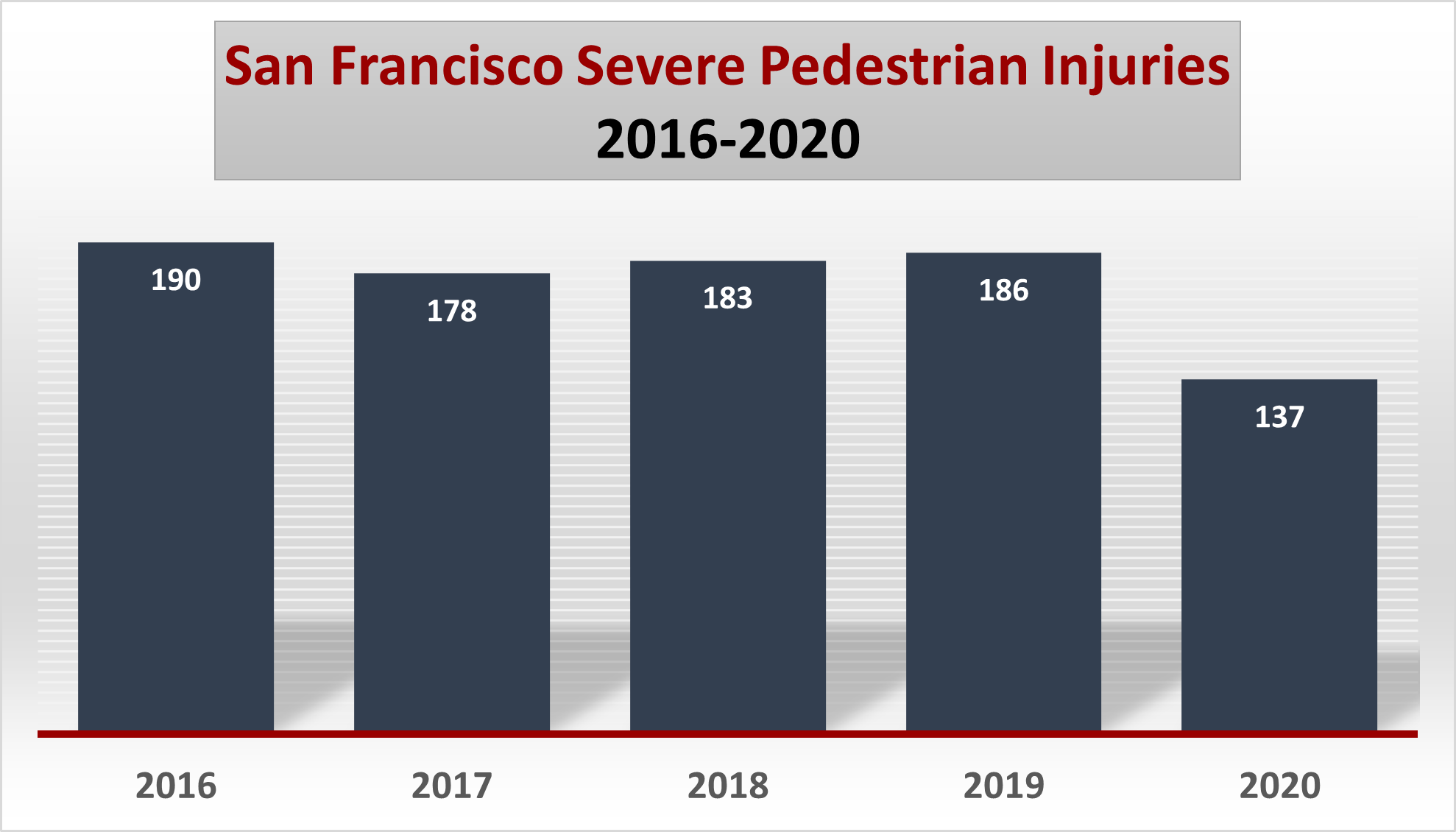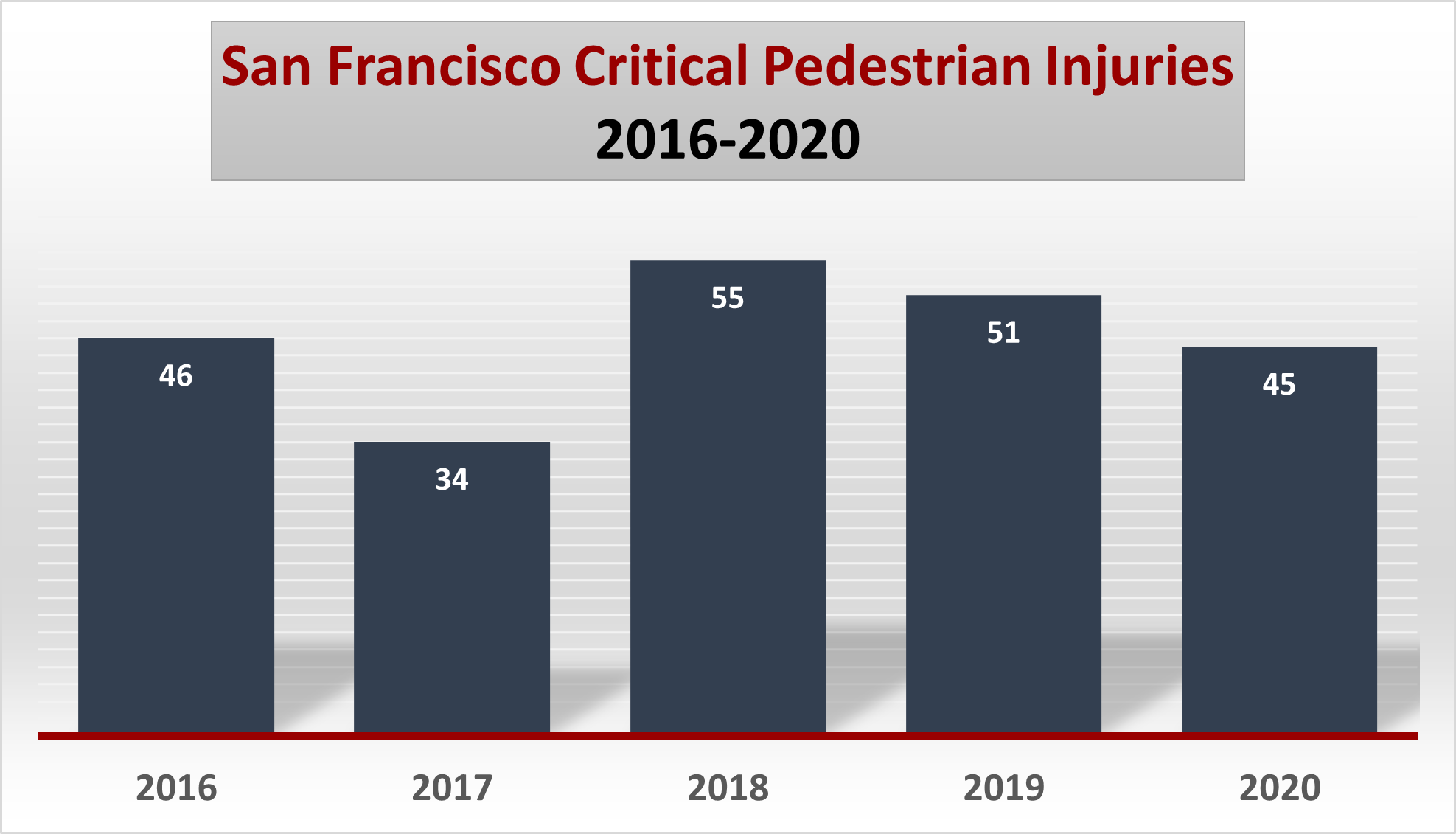The Department of Public Health recently published a new report on pedestrian injuries in San Francisco over the past decade. It highlights the mixed results San Francisco has garnered while city leaders have worked to improve traffic safety through the Vision Zero program.
The report examined the past ten years of victim data from the Trauma Center at Zuckerberg San Francisco General Hospital (ZSFG).
It was compiled to show the gains the city has made in traffic safety since the adoption of the Vision Zero program in 2014 and spotlight the areas that need more work. It’s also a first comprehensive look at the year that was 2020 and the effects a pandemic had on pedestrian accident numbers.
Vision Zero Goals for Motorists, Bicyclists, and Pedestrians
In 2014, San Franciso leaders laid out the Vision Zero plan to eliminate traffic fatalities by the year 2030 and reduce traffic injuries on our streets.
To track the effectiveness of the plan, the SFDPH has monitored the pedestrian patients brought to ZSFG. The hospital is San Francisco’s Designated Level I Trauma Center and that means pedestrians with severe injuries usually end up in its emergency department. By monitoring each patient’s trajectory, researchers get a well-rounded view of the levels of danger local pedestrians face on our streets.
A Vision Zero Team compiled trauma registry data from the hospital and uses the figures to assess the wellbeing of San Francisco pedestrians each year.
Tracking San Francisco Pedestrian Injuries
Vision Zero’s report card of sorts allows us to visualize the ups and downs of pedestrian safety in San Francisco. It offers a detailed look at what’s going on at crosswalks and sidewalks along our busy streets and charts the course of the victims of driver negligence.
For statistical purposes, the victims who show up at ZSFG after local accidents are grouped into two categories, the severely injured and the critically injured.
Severe pedestrian injuries are those that result in hospital admission for victims. Pedestrian injuries are labeled as critical when they reach a certain point on the Injury Severity Scale (ISS). The clinical scale ranges from 1-75. Any injury rated by medical authorities as a 15 or greater is considered critical. It should be noted that the severe injury category includes critical injury patients.
The report points out that defenseless pedestrians are the group of road users most affected by severe injury. In 2019, the number of pedestrians in accidents suffering severe injuries reach 35%. That was the highest percentage for any category of traveler. In 2020, the percentage dropped to 27%. Somewhere around the same percentage of motorists in accidents were documented as having severe injuries in 2020.

As the report highlights, severe pedestrian injury cases treated at ZFSG Hospital slowly rose from 2017 to 2019. There was a dramatic drop-off in cases in 2020 of almost 50 patients. Yet, it’s hard to put much faith in the notion that it’s a positive trend. The most probable explanation is that the traffic lulls associated with the COVID-19 pandemic contributed to the downtick in victims.
Critical injury numbers for pedestrians in San Francisco didn’t see quite such a dramatic dive in cases. 45 pedestrian patients admitted to ZSFG were suffering from critical injuries. It will be interesting to see if the fairly large surge in critical injuries that started in 2018 carries over to 2021 and beyond.

2020’s Effects on Traffic Safety Data
The monumental effects the pandemic had on everyone’s lives and on our city as a whole will likely take a long time to quantify. The changes in traffic levels, the downturn in commuter trips, fewer tourists, and other adjustments to the COVID-19 outbreak all contributed to a confusing picture that may not help us predict the path forward.
The SFDPH warns that the city and its residents can’t draw long-term conclusions by comparing 2020 statistics to previous years.
In fact, not all traffic accident numbers dropped in 2020. Bicycle accident injuries unexpectedly hit astounding highs over the year. Cases of severe injuries for cyclists rose by almost 40 cases from 2019 figures. Cases of critical injuries rose by eight between the two years.
Hope for the Future for San Francisco Pedestrians
When 2021 accident and injury data can be tabulated, it will provide an important litmus test for San Francisco.
Will the calming effect 2020’s turmoil provided on many city thoroughfares continue? 2021’s data will demonstrate if we were able to build on the overall safer traffic conditions that the pandemic provided.
We may also find that the gains were a one-year blip in an otherwise continued escalation of accident and injury rates. No matter the findings, it’s important that local communities and city government partner up on finding ways to give pedestrians, bicyclists, and motorists a safer path. It’s vital to continue the march to Vision Zero no matter how many setbacks we encounter.






